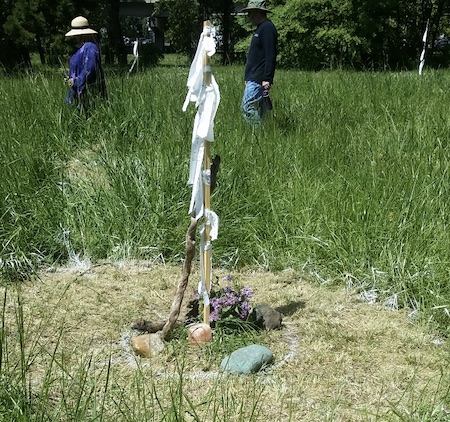Using the Labyrinth with Rites of passage, Ritual and Ceremony

Overview
The labyrinth has a long history of use in ceremony and ritual–including a ritual that was said to have been carried out but priests at Chartres Cathedral at Easter, a dance enacting the Trojan War carried out on classical labyrinths, and blessings for fishing catches on the coastal labyrinths of Scandinavia, among others.
The labyrinth lends itself especially to ceremonies that involve transition from one stage in life to another, or “rites of passage”. It is a "liminal" space, or a place where the normal rules of time and space are temporarily suspended. Coming into such a place often involves uncertainty, and this is usually an important part or rituals marking a transition from one stage of life to another.
What's more, the stages of walking a labyrinth suggests going from one place to another, while receiving something new as part of this journey. So, we cross the threshold when we enter into the labyrinth, walk in towards the centre (giving up what we had, or going away from where we came from), wait and receive at the centre, and then return renewed or “reborn” on our walk out, with a resolve to apply what we have received, or live according to the change that has affected us.
Any rite of passage may usefully be marked by walking a labyrinth, perhaps as part of a wider ceremony. A labyrinth having two entry paths offers other possibilities–for example, a bride and groom who are marrying may enter the labyrinth from different points, meeting at the centre to secure their union, then leave by a single path together.
Parents with children who are divorcing, conversely, might make a promise at the centre to jointly continue to care for and protect their children, before calmly walking apart along separate paths.
Many ceremonies may involve an intermediary or minister, including those who have trod the same path before (or have been through the same transition), and who may impart knowledge or invite those who are going through a transition to experience something new as a part of their experience.
Some level of "stage management" might therefore be relevant in some ceremonies involving the labyrinth, potentially including readings being offered, or actions being taken at certain terms along the labyrinth’s path.
There is no limit to possible applications, provided these are meaningful for the participants and what the ritual or ceremony seeks to achieve.
Ceremony plays an important role in helping individuals navigate important times of life.
Rituals, symbolic or meaningful actions undertaken within a ceremony, often involve making commitments, or believing that there is a higher purpose beyond what is being physically performed.
Among many important reasons for ceremony or ritual are rites of passage, important points of transition that we undertake in life–such as being born and passing into adulthood, as well as others that are very common for many people, such as when two people are married
The labyrinth is especially suited to rituals of this kind, being a "liminal space", and offering a threshold to pass over and path to follow to "set aside" an old way of life, and a return along a path and cross a threshold after being changed. The labyrinth therefore symbolises and supports transformation and commitment to a new way of being.
Possible applications
Rituals are intended to be serious actions that are symbolic of taking some step, remembering something significant, or making a meaningful offering. They often play an important part in ceremony. As a person is walking the labyrinth, they may be offered words of wisdom, or be presented with a challenge. They may be encouraged to see the labyrinth as going deeper in life (and within themselves), of making themselves vulnerable, and ready to accept whatever may come–while conscious that they are being held. Possibly, they may walk blindfolded while walking, while being guided by another person.
Challenges, readings, or statements to reflect upon might form a part of what is offered as they progress into the labyrinth. These may involve them repeating words that are offered to them as teaching or for reflection, to promise to make themselves open and ready for changes that face them, and similar challenges.
The centre might be used as a place for meditating on what is changing for them, perhaps where they may be held in silence for a while.
The path of a labyrinth might represent a direction to coming into their new state of being, having been transformed in the centre. During this walk, they may be encouraged to commit to their new responsibilities, and to accept that they have now passed into a new stage of their lives.
Challenges may be offered by different people, by giving readings or important texts to reflect upon, or by encouraging them to pick up cards that may have been placed along the labyrinth’s path. These may be presented at different turns of the labyrinth, being reflected upon along the next part of their walk, before they are presented with another challenge or text.
As a metaphor for life as a whole, arriving at the centre of the labyrinth is often seen to be the point at which an individual comes to a new home, or a point of harmony–a point at which they are "dead to their old ways". This is the way that the Tohono O’odham Native American people view the labyrinth’s path, for example. The same concept might be applied for completing a stage in life, and coming to "arrive" at a new point of maturity.
Labyrinths may be used for events involving more than one person. For example, labyrinths with two paths may be especially suited for weddings, where two people enter from different places, and come to the same centre. They may return along a single path together.
In reverse, this approach could be used for individuals who are resolving when separating from a marriage to do so peaceably, and to respect their mutual interests and obligations.
Such ceremonies can also be carried out where a labyrinth only has a single path–perhaps by one person arriving at the centre first, and then waiting while their partner makes the same journey to meet them.
The outer path from the centre need not be a long one, if it is more appropriate for the ritual for this stepping back into the world to be done quickly. An individual can simply walk straight from the centre to the labyrinth’s threshold, without needing to retrace the full path.
Points to consider
Holding individuals who are undergoing transformation in a ritual or ceremony is very important. After-care may be especially relevant, although this can also be a time for sharing in celebration with them (depending upon the purpose of the ceremony or ritual).
It's important to appreciate the power of ritual and transformation, but these are characteristic of the labyrinth too.
It may be wise to generally avoid over complicating or including too much in a single ceremony or ritual. Much internal processing can be going on for the individuals concerned, even if this is unseen.
For individuals who are properly prepared for this, some ceremonies can be conducted on the labyrinth alone.
Ceremonies and rituals can be conducted retrospectively. For example, a rite of passage ritual marking the transition from adolescence to adulthood that didn't occur in a person’s earlier life can be conducted when they are older. As a liminal space, the transformation that occurs within the labyrinth transcends our normal concepts of time and space.
For further information, see:
A ceremony for two people who want to renew their wedding vows (PDF download template, Rev. Clive Johnson, copyright free)
Labyrinths for rituals and ceremonies (article, Rev. Sig Lonegren, The Labyrinth Society)
Labyrinths and Ritual in Scandinavia (Website article, Freyia Völundarhúsins / Lady of the Labyrinth's Old Norse Mythology)
We welcome contributions and suggestions to add to this body of guidance, including applications not currently listed. Please contact us at support@labyrinthlaunchpad.org if you have ideas to contribute.
Supporting labyrinth lovers worldwide.










